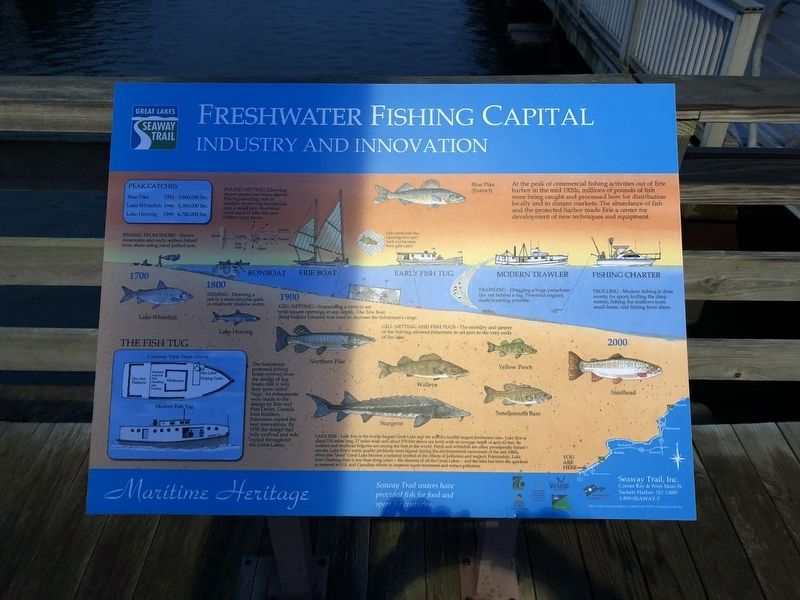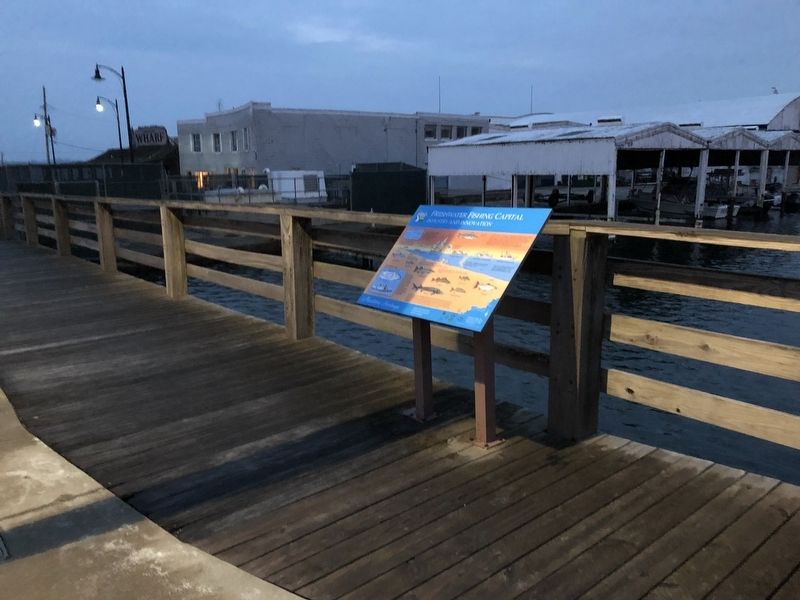Erie in Erie County, Pennsylvania — The American Northeast (Mid-Atlantic)
Freshwater Fishing Capital
Industry and Innovation
Blue Pike - 1931 - 3,600,000 lbs.
Lake Whitefish - 1946 - 8,300,000 lbs.
Lake Herring - 1949 - 6,700,000 lbs.
Pound netting (Drawing shows pound net from above) - Placing standing nets in shallow water that funnel fish into a small pen. Row boats were used to take the nets farther from the shore.
Fish swims into the openings but can't back out because their gills catch.
At the peak of commercial fishing activities out of Erie harbor in the mid 1920s, millions of pounds of fish were being caught and processed here for distribution locally and to distant markets. The abundance of fish and the protected harbor made Erie a center for development of new techniques and equipment.
1700
Fishing from shore - Native Americans and early settlers fished from shore using hand pulled nets.
1800
Seining - Drawing net in a semi-circular path in relatively shallow water.
1900
Gill netting - Suspending a vertical net with square openings at any depth. The Erie Boat (boat builder Loomis) was used to increase fishermen's range.
Gill netting and fish tugs - The mobility and power of the fish tug allowed fishermen to set nets to the very ends of the lake.
Trawling - Dragging a huge parachute-like net behind a tug. Powerful engines made trawling possible.
2000
Trolling - Modern fishing is done mostly for sport; trolling the deep waters, fishing the shallows from small boats, and fishing from the shore.
The Fish Tug
The first steam powered fishing boats evolved from the design of the tug boats, that is why they were called 'tugs'. As refinements were made to the design by Erie and Port Dover, Canada boat builders, fishermen copied the best innovations. By 1950 the design had fully evolved and was copied throughout the Great Lakes.
Lake Erie - Lake Erie is the fourth-largest Great Lake and the world's twelfth largest freshwater lake. Lake Erie is about 210 miles long, 57 miles wide and about 570 feet above sea level, with an average depth of only 62 feet. Its walleye and steelhead fisheries are among the best in the world. Perch and whitefish are other prominently fished species. Lake Erie's water quality problems were legend during the environmental movement of the late 1960s, when this "dead" Great Lake became a national symbol of the effect of pollution and neglect. Fortunately, Lake Erie's flushing time is less than three years -- the shortest of all the Great Lakes -- and the lake has been the quickest to respond to U.S. and Canadian efforts to improve waste treatment
Topics and series. This historical marker is listed in these topic lists: Animals • Environment • Industry & Commerce • Waterways & Vessels. In addition, it is included in the Great Lakes Seaway Trail National Scenic Byway series list. A significant historical year for this entry is 1931.
Location. 42° 8.209′ N, 80° 5.403′ W. Marker is in Erie, Pennsylvania, in Erie County. Marker is on State Street south of West Bay Road, on the right when traveling north. Touch for map. Marker is at or near this postal address: 5 State Street, Erie PA 16507, United States of America. Touch for directions.
Other nearby markers. At least 8 other markers are within walking distance of this marker. Captain Daniel Dobbins (about 400 feet away, measured in a direct line); Canal Basin (about 400 feet away); Dobbins Landing (about 500 feet away); Fort de la Presqu'ile (about 700 feet away); Alexis de Tocqueville (about 700 feet away); Making of the Flag "Don't Give Up The Ship" (about 800 feet away); Flagship Niagara (approx. 0.2 miles away); African American Sailors in the Battle of Lake Erie (approx. 0.2 miles away). Touch for a list and map of all markers in Erie.
Credits. This page was last revised on March 18, 2019. It was originally submitted on April 16, 2018, by Devry Becker Jones of Washington, District of Columbia. This page has been viewed 266 times since then and 11 times this year. Photos: 1, 2. submitted on April 16, 2018, by Devry Becker Jones of Washington, District of Columbia. • Andrew Ruppenstein was the editor who published this page.

